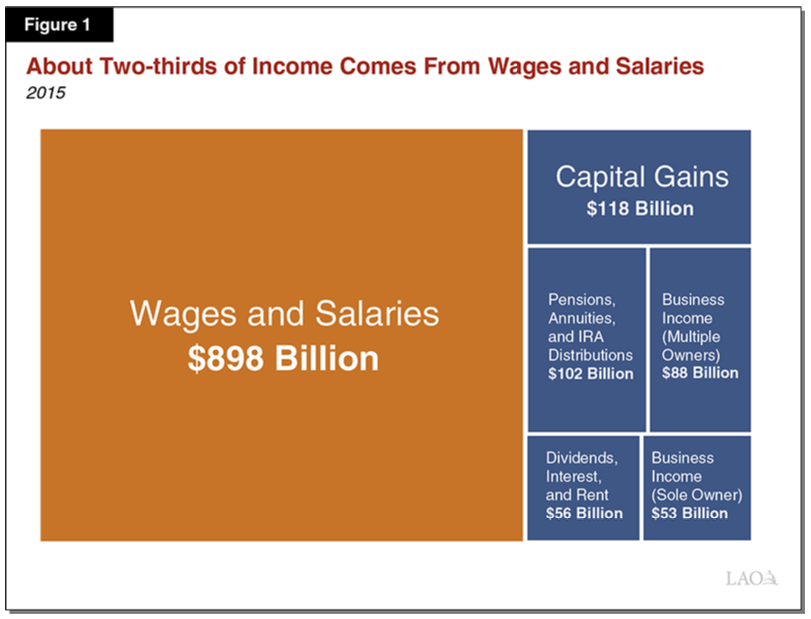Fiscal Outlook: Estimating Wages and Salaries
November 14, 2018
For other reports and posts related to our November 2018 Fiscal Outlook, see here.
The single largest source of General Fund revenue is the personal income tax (PIT). In order to estimate PIT revenue for our Fiscal Outlook publication, we must also make a projection of wage and salary income. This post discusses our method for making these estimates and some results of those estimates under our economic growth scenario.
Wage and Salary Income Largest Share of Personal Income. Most workers earning income in California pay state taxes on their wages and salaries. As Figure 1 shows, wages and salaries make up the largest component of the personal income. (Another major source of PIT revenues are capital gains, which we discuss in this post.)
Our Office Forecasts Wage and Salary Income by Industry. We project wage and salary income in over a dozen different “industry sectors.” Industry sectors consist of groups of businesses that are engaged in similar activities or are producing the same goods or services. For example, the retail trade sector includes stores that sell goods directly to customers. This includes gasoline stations, pharmacies, and grocery stores, among many others. As such, workers within an industry sector include many different job types. For example, the retail trade sector employs cashiers and salespeople, but also managers, accountants, and pharmacists. For each industry sector we project:
- Number of Jobs. We first project total employment by quarter using a set of related indicators. For example, to forecast changes in the number of jobs in the construction industry, we look at commercial and residential permit activity, as well as expected changes in employment in the construction industry in the rest of the nation.
- Average Wages and Salaries. For each sector, we also project average wages by quarter. Most of these industry forecasts use Moody’s U.S. Consensus forecast as a base and then add in additional variables to adjust for California-specific conditions. For example, in the case of the retail trade sector, our wages forecast looks at disposable income in California and changes in the state’s minimum wage.
Once we have constructed these projections for each of our industries, we multiply the number of jobs by average wages to get wage and salary income for that industry. Then, we add up all the industries, which yields our estimate of total wages and salaries for the state.
More Wage and Salary Income Growth Expected to Come from Wages, Rather Than Jobs. Figure 2 shows our projections of average annual growth in total wages and salaries, by industry sector, over our outlook period. We project total wage and salary growth will be highest (around 7 percent per year) for workers employed in the technology sector and lowest for workers in print media and telecommunications. The figure also shows what share of total growth in wages and salaries is expected to come from increases in average wages versus increases in the number of jobs. For most industry sectors, it is the latter—overall wage and salary growth is expected to result mostly from average wages, rather than jobs. This means that—mostly—existing workers’ wages are rising rather than additional people gaining employment. As California’s economy nears full employment, we expect job growth to slow and wage growth to remain steady.
Additional Notes. Some additional notes about our outlook for wages and salaries:
- Job Growth Remains Strong in Some Sectors. Job growth overall is expected to slow as the economy reaches full employment. We except job growth in two industry sectors, however, to continue expanding above 2 percent annually, a relatively strong rate. This includes employment in health care and social assistance and the technology sector.
- Both Jobs and Average Wages Grow Rapidly in the Technology Sector. We expect workers in technology sector jobs—which includes firms conducting data processing, software development, and web search, like Google and Facebook—to see strong growth in both average wages and jobs. Workers in these firms compose a small share of overall number of jobs in California—just 2 percent—but tend to have very high salaries. Consequently, statewide, these workers make up 6 percent of total wages and salaries. With robust growth over the period, we expect these workers to earn 11 percent of total wages and salaries in the state by 2023.
- Projected Wage Growth Is Strong in a Couple of Lower-Wage Sectors. Under our outlook, workers employed in some lower-wage sectors—most notably leisure and hospitality—also see robust wage growth. This is attributable, in part, to changes in the state minimum wage, which is scheduled to continue increasing over the outlook period.


